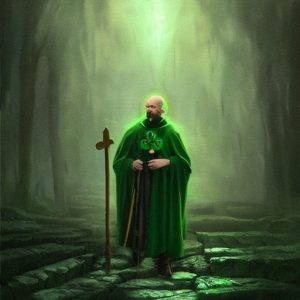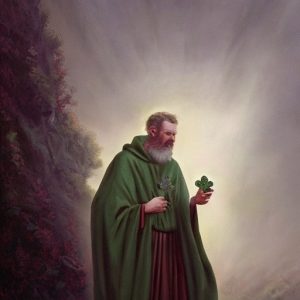
Two written documents attributed to St. Patrick offer astounding insights into his life, faith, teachings, and miracles. Learn more about this beloved saint through his own words.
St. Patrick was a fifth-century Christian missionary and bishop, known as the patron saint of Ireland. He is also celebrated as a cultural icon in Irish and Irish-American communities worldwide.
St. Patrick is believed to be the author of two written documents: his Declaration (Latin: Confessio) and his Letter to the soldiers of Coroticus (Latin: Epistola).
 Both the Declaration and the Letter to the soldiers of Coroticus feature the words and thoughts of St. Patrick and are the sources of most of the generally-accepted details of his life.
Both the Declaration and the Letter to the soldiers of Coroticus feature the words and thoughts of St. Patrick and are the sources of most of the generally-accepted details of his life.
Here are some of his famous quotes and details of his life from the Declaration and the Letter:
St. Patrick’s Confessions
St. Patrick was born in Britain in the late fourth century and was kidnapped by Irish raiders at the age of 16. He was taken to Ireland and enslaved for six years, during which he became a Christian and learned the Irish language and customs.
“The Lord opened my mind to an awareness of my unbelief, in order that, even so late, I might remember my transgressions and turn with all my heart to the Lord my God.” – St. Patrick
After escaping from slavery and returning to Britain, St. Patrick had a vision in which he heard the voice of the Irish people calling him to return and bring them the Gospel. He studied for the priesthood and was ordained a bishop before returning to Ireland as a missionary.
In his written Confessions, St. Patrick describes his motivation for this mission:
“I came to the Irish people to preach the Gospel and to endure the taunts of unbelievers, putting up with reproaches about my earthly pilgrimage, suffering many persecutions, even chains, and losing my birthright of freedom for the benefit of others.” – St. Patrick
 St. Patrick’s mission in Ireland was not an easy one. He faced many challenges and dangers, including hostility from the pagan tribes who inhabited the island. Nevertheless, he persisted in his efforts to spread the gospel, and his teachings emphasized the importance of faith, humility, and forgiveness.
St. Patrick’s mission in Ireland was not an easy one. He faced many challenges and dangers, including hostility from the pagan tribes who inhabited the island. Nevertheless, he persisted in his efforts to spread the gospel, and his teachings emphasized the importance of faith, humility, and forgiveness.
“I have come to love the Irish people and their customs, and for this reason, I have remained in Ireland, where I hope to die.” – St. Patrick
In one of his letters, St. Patrick writes: “May the strength of God pilot us, may the wisdom of God instruct us, may the hand of God protect us, may the word of God direct us. Be always ours this day and forevermore.”
The Shamrock and The Trinity
This prayer reflects St. Patrick’s trust in God’s guidance and protection as he went about his missionary work. One key aspect of St. Patrick’s teachings was his emphasis on the Trinity – the belief in one God in three persons (Father, Son, and Holy Spirit).
“I bind unto myself today the strong name of the Trinity, by invocation of the same, the Three in One, and One in Three.”– St. Patrick
St. Patrick used the symbol of the shamrock, a three-leaf clover, to explain this concept to the Irish people, showing how three leaves on one stem represented the three persons of the Trinity. This imagery is still associated with St. Patrick.
At the time, the concept of the Holy Trinity was not well understood by the Irish people, who were used to polytheistic religions. St. Patrick saw the shamrock, which was a common plant in Ireland, as a way to explain the concept of the Holy Trinity.
In his Confession, St. Patrick wrote, “I explained the Trinity to the Irish by using the three leaves of the shamrock to represent the Father, Son, and Holy Spirit.”
 He went on to describe how he used the shamrock to illustrate the unity and diversity of the Holy Trinity, saying, “They are distinct but not separate, just as the three leaves of the shamrock are distinct but connected by one stem.”
He went on to describe how he used the shamrock to illustrate the unity and diversity of the Holy Trinity, saying, “They are distinct but not separate, just as the three leaves of the shamrock are distinct but connected by one stem.”
St. Patrick’s use of the shamrock to explain the Holy Trinity was a simple yet powerful way to communicate a complex theological concept to a people who were not familiar with Christian teachings.
Today, the shamrock is a ubiquitous symbol of Irish culture and heritage, and it is often associated with St. Patrick’s Day, which is celebrated on March 17th each year. The use of the shamrock to explain the Holy Trinity has become an enduring part of St. Patrick’s legacy, and it is a reminder of the power of simple and effective communication in spreading ideas and beliefs.
As we celebrate St. Patrick’s Day and the rich heritage of Ireland, we can remember the power of the shamrock to bring people together and to inspire understanding and unity.
St. Patrick the Visionary
St. Patrick’s adventures as a missionary also included many miraculous events, according to his own accounts.
For example, he tells of how he once prayed for a group of sailors who were stranded on a rocky shore, and a ship miraculously appeared to rescue them. He also describes how he raised a man from the dead and healed many sick people through prayer.
 St. Patrick’s declaration describes a vision he had in which God spoke to him, saying, “He who gave his life for you is the one who speaks within you.” This vision had a profound impact on St. Patrick, reinforcing his commitment to spreading the Gospel in Ireland.
St. Patrick’s declaration describes a vision he had in which God spoke to him, saying, “He who gave his life for you is the one who speaks within you.” This vision had a profound impact on St. Patrick, reinforcing his commitment to spreading the Gospel in Ireland.
St. Patrick traveled throughout Ireland, preaching the Gospel and establishing churches and monasteries. He also baptized thousands of people and performed many miracles, including healing the sick and raising the dead.
“I arise today through the strength of heaven, light of sun, radiance of moon, splendor of fire, speed of lightning, swiftness of wind, depth of sea, stability of earth, firmness of rock.” – St. Patrick
St. Patrick wrote the Letter to the soldiers of Coroticus to denounce the killing and enslavement of Irish Christians by a British warlord.
St. Patrick’s Humility
St. Patrick’s mission in Ireland was not without challenges. He faced opposition from some of the Irish chieftains and Druids, who saw him as a threat to their power and influence. However, his message of love and forgiveness eventually won over many Irish people, and he became a beloved figure in Irish folklore and culture.
Despite his many successes, St. Patrick remained humble and mindful of his own weaknesses.
In his Confessions, he writes: “I am imperfect in many things, nevertheless I want my brethren and kinsfolk to know my nature so that they may be able to perceive my soul’s desire.”
 St. Patrick’s humility and sincerity were perhaps his greatest strengths as a missionary. Despite his successes in Ireland, St. Patrick remained humble and dedicated to his faith. In his declaration, he wrote, “I, Patrick, a sinner, a most simple countryman, the least of all the faithful, and most contemptible to many.”
St. Patrick’s humility and sincerity were perhaps his greatest strengths as a missionary. Despite his successes in Ireland, St. Patrick remained humble and dedicated to his faith. In his declaration, he wrote, “I, Patrick, a sinner, a most simple countryman, the least of all the faithful, and most contemptible to many.”
He died on March 17, which is now celebrated as St. Patrick’s Day.
St. Patrick’s Legacy
In conclusion, St. Patrick’s teachings and adventures as a missionary were shaped by his deep faith, his trust in God’s guidance, and his commitment to spreading the gospel message.
“Christ in the heart of everyone who thinks of me, Christ in the mouth of everyone who speaks of me, Christ in every eye that sees me, Christ in every ear that hears me.” – St. Patrick
Through his writings and confessions, we can gain insight into his motivations, his challenges, and his remarkable successes in bringing Christianity to Ireland.
Today, St. Patrick’s legacy lives on, not only in Ireland but around the world, as a symbol of faith, courage, and perseverance.
Learn more about St. Patrick in our article Secrets of St. Patrick
ST. PATRICK ITEMS
Click here to see them all



